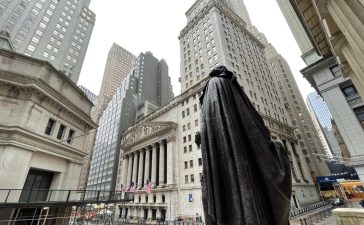All three major U.S. stock averages were down more than 2%, with the Nasdaq on course for its worst day in a month
Wall Street stocks dropped sharply on Friday as investor risk appetite was soured by the revived spectre of tariffs against China, threatened anew by U.S. President Donald Trump in retaliation for the COVID-19 pandemic which has brought global economies to a grinding halt.
All three major U.S. stock averages were down more than 2%, with the Nasdaq on course for its worst day in a month.
May is often marked by sell-offs, and on the month’s first day, with jitters on the rise as some U.S. states begin easing shutdown mandates, the adage holds true.
“Usually investors hinge onto the old ‘sell in May and go away,'” said Peter Cardillo, chief market economist at Spartan Capital Securities in New York. And while I don’t think that’s the case, I think this market will head lower.
This comes on the heels of April’s remarkable run, which saw the S&P 500 and the Dow posting their strongest monthly gains in 33 years.
Trump said his administration was crafting retaliatory measures against China as punishment for the coronavirus outbreak, once again sparking tariff fears that rattled markets through much of the last two years.
The last thing you want is (tariff) retaliation when the world economy looks like it’s headed into depression, Cardillo added. The coronavirus has put everything out of whack, but the economy was already weakening due to the trade war, and while Trump is not responsible for the coronavirus, he’s responsible for the trade war.
A mixed bag of earnings, particularly a disappointing report from Amazon.com, along with a fresh round of dismal economic data, also weighed on sentiment.
The U.S. manufacturing sector skidded to an 11-year low last month as factories were shuttered to comply with mandated shutdowns, according to the Institute for Supply Management’s (ISM) purchasing managers index (PMI).
The Dow Jones Industrial Average fell 656.85 points, or 2.7%, to 23,688.87, the S&P 500 lost 88.9 points, or 3.05%, to 2,823.53 and the Nasdaq Composite dropped 300.88 points, or 3.38%, to 8,588.68.
All 11 sectors of the S&P 500 were in the red, with energy companies suffering the largest percentage drop.
Reporting season has crossed the halfway mark, with 275 of the companies in the S&P 500 having reported. Of those, 68% have beaten consensus estimates.
In aggregate, first-quarter S&P 500 earnings are seen falling 12.7% from a year ago, a sharp reversal from the 6.3% annual growth forecast as it stood at the beginning of the year.
Tesla Inc plunged 9.4% after a tweet from company Chief Executive Elon Musk said its stock price was “too high.”
Amazon.com shares slid 6.9% after the online retailer warned pandemic-related expenses could lead to its first quarterly loss in five years.
Apple Inc’s quarterly results beat expectations, but the iPhone maker declined to provide current-quarter forecasts. Its shares were off 1.3%.
Exxon Mobil dropped 6.1% after the company reported a drop in profit due to a massive $3 billion writedown on plummeting oil demand and prices.
Rival Chevron Corp posted a 38% profit increase and slashed spending plans. Its shares were down 2.0%.
Declining issues outnumbered advancing ones on the NYSE by a 7.16-to-1 ratio; on Nasdaq, a 6.52-to-1 ratio favoured decliners.
The S&P 500 posted no new 52-week highs and two new lows; the Nasdaq Composite recorded 16 new highs and 10 new lows.





